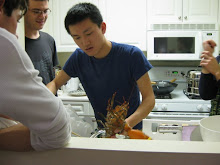A few weeks ago, I was walking past a vegetables stand and saw Thai eggplant, small green golf-ball--sized pellets. I couldn't resist and purchased a pound of the eggplants.

When I got home, I was perplexed. I had never cooked with Thai eggplant before and had no idea how to cook them. I decided to taste the vegetable. I cut one open -- it was incredibly seedy. The flavor was similar to normal eggplant. I noticed that the flesh seemed porous and absorbent. Then it hit me. Curry! A delicious curry sauce would be sopped up by the flesh of the eggplant. I had used normal eggplant in curries before and so I knew it would work.
I modified a standard recipe for curry that is the basic archetype from which all curries are built; you probably already know it. Turmeric root, cumin, and coriander are toasted until fragrant, then grounded up with garlic and peppers in a spice mill. You can add ginger too. Then diced onions are fried until translucent. Lastly, tomatoes and coconut milk are added. The result is Curry with Thai Eggplant.
I looked in the fridge hoping for some chicken, but no luck, only half a chicken breast. I prayed and hoped and crossed my fingers and opened the freezer. Eureka! I found a packet of snowy halibut. I had just stuck it in the freezer a mere few days ago, and I vacuum sealed it so it didn't suffer from freezer burn in any way.
First, I toasted some of the spices. Here we see cumin, coriander, and turmeric being toasted in a small saucepan.
 I love my spice mill. You can make "dry" sauces so easily with one. Instead of chopping herbs, garlic, ginger, spices, parsley, cilantro, et cetera etcetera etcetera, just dump it all in the spice mill and coarsely grind. The more finely you grind it up, the more flavorful it will become. I'm not sure if they start to react after a certain point though, so I only ground until it was a coarse paste.
I love my spice mill. You can make "dry" sauces so easily with one. Instead of chopping herbs, garlic, ginger, spices, parsley, cilantro, et cetera etcetera etcetera, just dump it all in the spice mill and coarsely grind. The more finely you grind it up, the more flavorful it will become. I'm not sure if they start to react after a certain point though, so I only ground until it was a coarse paste.
 In a medium skillet, I heated some oil and added the chopped onion, cooking a few minutes until it softened.
In a medium skillet, I heated some oil and added the chopped onion, cooking a few minutes until it softened. I added the curry paste and cooked some more, trying to break up large pieces as best I could (it starts to stick together since it's a dry paste).
I added the curry paste and cooked some more, trying to break up large pieces as best I could (it starts to stick together since it's a dry paste). I added chopped tomatoes (You can peel the tomatoes if you want; I didn't) and cooked a minute or two. If desired, you can always remove the large pieces of tomato skin. I don't really mind it.
I added chopped tomatoes (You can peel the tomatoes if you want; I didn't) and cooked a minute or two. If desired, you can always remove the large pieces of tomato skin. I don't really mind it. I added about a cup of coconut milk (same amount as the tomatoes), and mixed. I loved the melding of the colors.
I added about a cup of coconut milk (same amount as the tomatoes), and mixed. I loved the melding of the colors. I let this simmer (on medium or low) for about 10 minutes so that the tomatoes were breaking down. Meanwhile, I cubed chicken breast and the halibut...
I let this simmer (on medium or low) for about 10 minutes so that the tomatoes were breaking down. Meanwhile, I cubed chicken breast and the halibut... I also quartered the Thai eggplants and mixed them into the curry. They benefit from extended cooking time as the curry has a chance to soak into the eggplants and give them a more flavorful characteristic.
I also quartered the Thai eggplants and mixed them into the curry. They benefit from extended cooking time as the curry has a chance to soak into the eggplants and give them a more flavorful characteristic. I tasted the curry and deemed it worthy of the protein I was about to add. The chicken and halibut were added to the curry mixture and I cooked it thoroughly, until the fish and meat were cooked. If you are worried about overcooking the fish, I would add the chicken first, cook a few minutes (not completely), then add the fish.
I tasted the curry and deemed it worthy of the protein I was about to add. The chicken and halibut were added to the curry mixture and I cooked it thoroughly, until the fish and meat were cooked. If you are worried about overcooking the fish, I would add the chicken first, cook a few minutes (not completely), then add the fish. For a finishing touch, I added chopped cilantro and incorporated.
For a finishing touch, I added chopped cilantro and incorporated.
The end product had a terrific kick. The Thai eggplants were the star of the dish; the seeds provided fun texture and the flesh soaked up the zingy curry flavor. The curry was both spicy and cooling. There was also well-balanced counterpoint between the spice of the peppers, the spice of the ginger, and the coolness of the coconut milk.
Sources:
Thai eggplant from Chinatown
Produce from Whole Foods
Halibut from Costco



Yum!! thai eggplants are so cute!
ReplyDelete